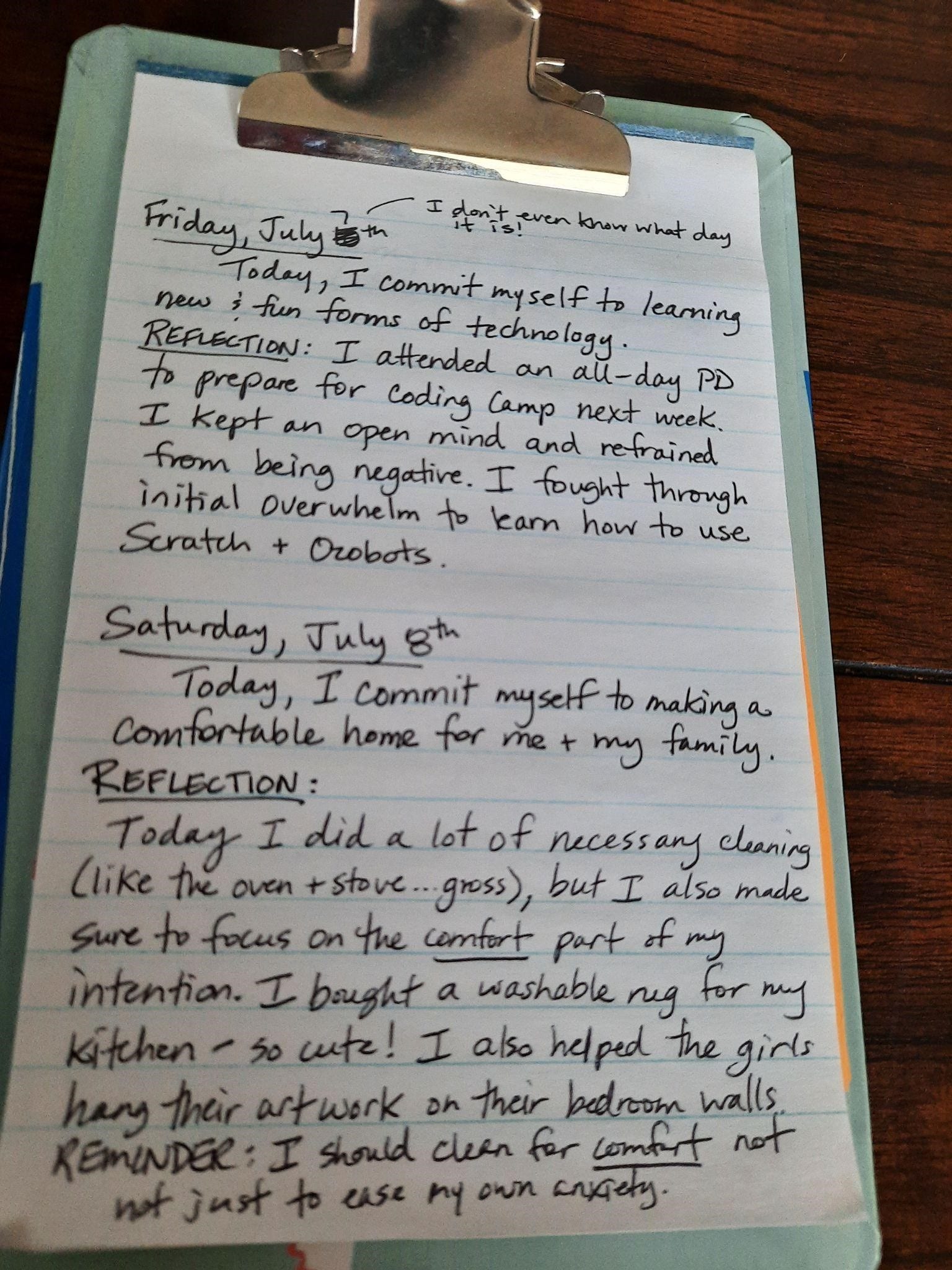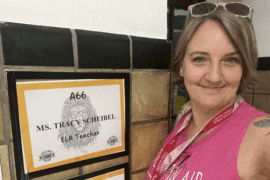A Teacher’s Guide to Finding Peace and Focus through the Habit of Daily Intentions
Back in May I was sitting on a bench outside my school on lunch break. I was stressed about preparing students for state testing and just generally overwhelmed by all the events that happen in May. My colleague, a veteran teacher with over 30 years of experience, was sitting with me and quietly knitting. She often did this at lunch, after taking a walk around the building. She rarely seemed stressed, despite running the GED program and dealing with some of the most challenging students in the whole school. That day I decided to ask the secret to her peaceful demeanor. She told me that, besides unplugging and doing relaxing things every lunch hour, she also set her intentions for the day every morning in her journal. After years of doing it, she said she had trained herself to keep her intention in her mind all day and that often her intention related to staying calm and at peace.
As summer started, I decided it would be the perfect time to test out setting daily intentions. Summer just always seems to sneak away from me; time moves so fast. I wanted to be more intentional about using that time, especially to spend it well with my daughters. Also, I was going to be helping to facilitate a coding camp for K-5th graders for two weeks. This was a new challenge that I was, frankly, nervous about. If I could be intentional about how I wanted to spend each day of the camp, I reckoned it could help ease my anxiety and create a better experience overall.
Before starting my 30 day experiment I did some research around best practices for setting intentions. What follows are the tips I found followed by a summary of my personal experience setting intentions. While your experience will likely be a bit different than mine, I now believe that setting a daily intention is a simple habit that can result in profound benefits.
What is an intention?
Before I could set an intention, I needed to understand what one was. How was it different from a goal? I didn’t know. I found the most helpful explanation came from neuropsychologist Sanam Hafeez in this article for The Healthy: “[an intention] can be the kind of life you want to live, how you want to act in a particular situation or what you want to get out of an experience…” Later in the article it made clear that “while goals focus on a specific end point—suggesting that your current status is unacceptable or unsatisfactory—intentions are more about your mindset and mindfulness in the present as you make your way towards something that’s important to you.” So basically, I needed to ask how I wanted to be and feel that day while I was accomplishing the tasks at hand.
To help set my daily intention I decided to use the phrase below from this Becoming Minimalist article.
Today, I commit myself to…
A different article from A Blissful Mind offered these helpful examples of possible intentions:
Today, I commit myself to…
- Staying focused on my to-do list
- Being present in the moment
- Sticking up for my own beliefs
- Listening to my intuition and let it guide me
- Enjoying my creativity
- Being organized with my work
- Opening myself to new possibilities without shutting myself down
- Staying in my heart, not my head
- Prioritizing x, y, z (what matters most that day)
- Embracing change in all forms
Tips for Making the Most of Our Intentions
Every article I read about setting intentions recommended doing so first thing in the morning. The above-mentioned article from A Blissful Mind also recommended setting one in conjunction with something you do every morning so you won’t forget. It could be while you prepare your breakfast or brush your teeth. I decided to do it while drinking my tea.
The article also recommended setting reminders on your phone of your intention (I set an alarm that went off at lunch each day) or putting up low-tech sticky notes as reminders. Further, multiple articles suggested spending a little time each night reflecting on whether you succeeded in following your intention. This can be an informal thing, but I decided to make it more formal by jotting down a few thoughts. I wanted to be able to look back over my intentions and reflections at the end of the 30 days to help me decide if the experiment had really been effective. I wrote everything on a simple notepad (see image below) – no fancy journal needed!

My Experience
The first thing I immediately realized is that setting intentions is hard! It really requires serious self-reflection. It made me grapple with tough questions like, how do I want to feel today? How do I want to treat others? How do I want others to feel around me? That wasn’t always easy to do at 7 in the morning. However, the second thing I realized is it got easier the more I did it. I also strongly felt that reflecting at the end of the day was crucial for me to really unpack how I was feeling and whether I had achieved my intention or needed to keep working on it in subsequent days. As a result, some days my intention remained the same, and some days it changed.
My final, and most important, realization was that setting an intention helped me through stressful situations. While the coding camp I worked at was a positive experience, it also forced me to leave my comfort zone and stretch my skills. It involved teaching an age group I hadn’t worked with in over 20 years using tech tools (like Scratch and Minecraft and Ozobots) that I was learning on the fly. Yikes! But as I leaned into my intentions – which often revolved around having fun and being open to learning new things – I found myself learning so much from the students I was working with. And boy, I forgot how brutally honest and hilarious little friends can be, and I reveled in it. Things didn’t go perfectly every day, but focusing on my positive intentions helped me weather the challenges. I genuinely enjoyed my experience more because my intentions were clear and present in my mind.
The previously-mentioned article from The Healthy reinforced what I experienced by stressing that setting intentions is particularly helpful for people with anxiety or people facing a tough season in life because it “gives you a higher degree of control over your life.” Hard situations may arise throughout the day: rain spoils plans, technology doesn’t work when you need it to, a conversation proves difficult. You may be facing hard choices like whether to leave a job or end a relationship or how to best support an aging family member. But if you get clear on how you want to handle what comes at you and how you want to feel or make others feel, you are already on your way to dealing with the challenges in a more productive way. Some days you will fall short of your intentions, and that’s okay. Try again tomorrow. At least you know the direction you want to go.
– Megan Panek





